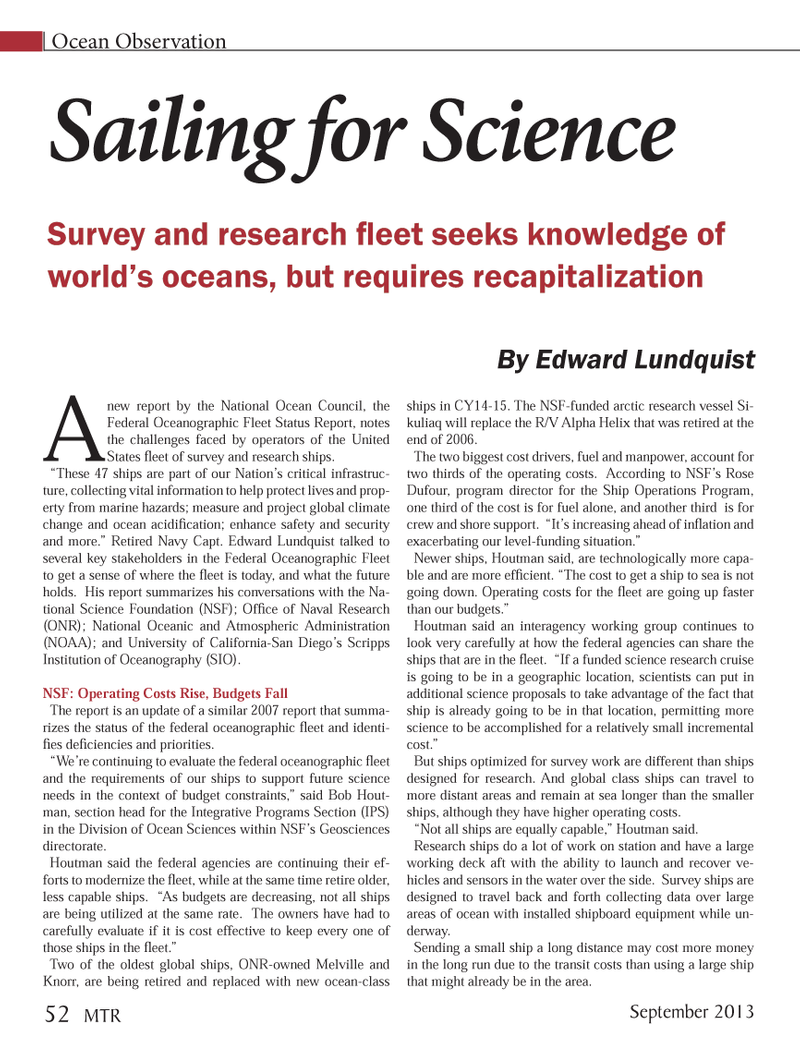
Page 52: of Marine Technology Magazine (September 2013)
Ocean Observation: Gliders, Buoys & Sub-Surface monitoring Networks
Read this page in Pdf, Flash or Html5 edition of September 2013 Marine Technology Magazine
A new report by the National Ocean Council, the Federal Oceanographic Fleet Status Report, notes the challenges faced by operators of the United States ß eet of survey and research ships. ÒThese 47 ships are part of our NationÕs critical infrastruc- ture, collecting vital information to help protect lives and prop- erty from marine hazards; measure and project global climate change and ocean acidiÞ cation; enhance safety and security and more.Ó Retired Navy Capt. Edward Lundquist talked to several key stakeholders in the Federal Oceanographic Fleet to get a sense of where the ß eet is today, and what the future holds. His report summarizes his conversations with the Na- tional Science Foundation (NSF); OfÞ ce of Naval Research (ONR); National Oceanic and Atmospheric Administration (NOAA); and University of California-San DiegoÕs Scripps Institution of Oceanography (SIO).NSF: Operating Costs Rise, Budgets Fall The report is an update of a similar 2007 report that summa-rizes the status of the federal oceanographic ß eet and identi-Þ es deÞ ciencies and priorities. ÒWeÕre continuing to evaluate the federal oceanographic ß eet and the requirements of our ships to support future science needs in the context of budget constraints,Ó said Bob Hout- man, section head for the Integrative Programs Section (IPS) in the Division of Ocean Sciences within NSFÕs Geosciences directorate.Houtman said the federal agencies are continuing their ef-forts to modernize the ß eet, while at the same time retire older, less capable ships. ÒAs budgets are decreasing, not all ships are being utilized at the same rate. The owners have had to carefully evaluate if it is cost effective to keep every one of those ships in the ß eet.Ó Two of the oldest global ships, ONR-owned Melville and Knorr, are being retired and replaced with new ocean-class ships in CY14-15. The NSF-funded arctic research vessel Si- kuliaq will replace the R/V Alpha Helix that was retired at the end of 2006.The two biggest cost drivers, fuel and manpower, account for two thirds of the operating costs. According to NSFÕs Rose Dufour, program director for the Ship Operations Program, one third of the cost is for fuel alone, and another third is for crew and shore support. ÒItÕs increasing ahead of inß ation and exacerbating our level-funding situation.Ó Newer ships, Houtman said, are technologically more capa- ble and are more efÞ cient. ÒThe cost to get a ship to sea is not going down. Operating costs for the ß eet are going up faster than our budgets.Ó Houtman said an interagency working group continues to look very carefully at how the federal agencies can share the ships that are in the ß eet. ÒIf a funded science research cruise is going to be in a geographic location, scientists can put in additional science proposals to take advantage of the fact that ship is already going to be in that location, permitting more science to be accomplished for a relatively small incremental cost.Ó But ships optimized for survey work are different than ships designed for research. And global class ships can travel to more distant areas and remain at sea longer than the smaller ships, although they have higher operating costs. ÒNot all ships are equally capable,Ó Houtman said. Research ships do a lot of work on station and have a large working deck aft with the ability to launch and recover ve- hicles and sensors in the water over the side. Survey ships are designed to travel back and forth collecting data over large areas of ocean with installed shipboard equipment while un-derway. Sending a small ship a long distance may cost more money in the long run due to the transit costs than using a large ship that might already be in the area.Ocean Observation Sailing for Science Sailing for Science Survey and research ß eet seeks knowledge of Survey and research ß eet seeks knowledge of world?s oceans, but requires recapitalization world?s oceans, but requires recapitalization By Edward Lundquist September 201352 MTRMTR #7 (50-65).indd 52MTR #7 (50-65).indd 528/22/2013 11:27:02 AM8/22/2013 11:27:02 AM

 51
51

 53
53
